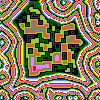

The left picture shows a chessboard arrangement and is used here for mode standard, WaTor, brians brain and HPP.
The right picture shows a shifted grid and is logical the same as a honeycomb. It is the base of the mode hexagonal.
There are much more tilings thinkable. In the following description only the standard mode is treated.
The single cell on the field have a discrete state, in this app a value between 0 and 9.
Cells with these different values are displayed with different colors (0 = black, 1 = green, 2 = blue, etc.) You may change this color sheme..
Furthermore there have to be defined a neighbourhood:




On the left picture you see, that the cell gets 8 neighbours (green). This is known under the name Moore neighbourhood and is used by the mentioned Game of Life.
The second is called von Neumann neighbourhood. The cell itself can be part of the neighbourhood.
In this app you can define the neighbourhood freely.
At last we have to define a transformation regulation (rule), which determines the changing of the cell values by transition to the next generation.
This app is using in standard and hexagonal mode socalled "totalistical" rules. This means all values of the neighbours are added to a sum. This sum and the rule table determines the new value of the cell.
Let's do an example::
 (0=white, 1=green, 2= blue)
(0=white, 1=green, 2= blue)